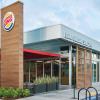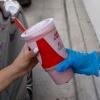Krispy Kreme loves its partnership with McDonald's. The company has expressed that feeling for months and re-emphasized it Thursday to investors. But as to how well the team-up is doing sales-wise or what the future may look like for expansion—neither has been clear.
The two sides joined forces in the fall when Krispy Kreme said it would start delivering fresh doughnuts daily to nine Louisville-based McDonald's restaurants. In February it was announced the deal would expand to roughly 160 stores.
Krispy Kreme CEO Michael Tattersfield said it's too early to share specific results around the partnership because the bigger pilot has only been live for six weeks. He did note that while grocery stores often require early-morning drop-offs, McDonald's restaurants can facilitate other times of the day. Krispy Kreme is indeed sending doughnuts daily, and Tattersfield said the fast-food giant has been a "fantastic partner so far in understanding this is a fresh daily proposition."
"That's how we see our delivered fresh daily business and channel expanding, whether it's in [quick-service] or some of these other newer channels," the CEO said during the brand's Q1 earnings call. "So I think that we certainly see it as a fresh daily business. That's how we've built it, providing those amazing doughnuts to folks off-premise in all these more convenient locations. Because as you may have heard us say before, the number one reason why somebody might not buy a Krispy Kreme—they didn't come across it. It's not convenient for them and an opportunity like this, obviously, makes it a lot more convenient for them when they see it."
This is one of the biggest opportunities for Krispy Kreme's new operating model, which involves production center hubs distributing fresh doughnuts every day to spokes, otherwise known as points of access.
READ MORE:
Insomnia Cookies Dreams of 4,000 Stores Worldwide
Organic Sales Spike at Krispy Kreme, Yet More Shops Will Shutter
Krispy Kreme Feels Drag from its Older Operating Model
Tattersfield said the brand is servicing these McDonald's locations with three existing production hubs and that the doughnut chain hasn't seen any negative impact on existing sales at retail shops or other delivered fresh daily doors (grocery, convenience stores, gas stations, etc.). That's because McDonald's customers aren't going to restaurants specifically for doughnuts. But, as CFO Josuha Charlesworth said, "Once they're there, they go out, it's available here. I'll pick it up."
"The way we're thinking about it is let's just make it more convenient," Charlesworth said. "Get those awesome fresh doughnuts to people where they want to pick them up. And we're just learning as we go. The demand is there in multiple locations."
Krispy Kreme added delivery trucks and doubled production in existing hubs to satisfy demand from McDonald's. In this relationship, the company sometimes drops off doughnuts at each McDonald's restaurant and other times it will connect with a third-party logistics team to do the delivery.
Also important to note, McDonald's controls demand planning, meaning it determines how much product it wants each day as opposed to Krispy Kreme forecasting the number.
"We saw the opportunity there to really ramp up production and support them in the way that's needed," Tattersfield explained. "And we'll continue to partner with them on what's the right way of doing this, what are the right targets, what are the right measures. They're the experts on the impact on McDonald's. I think we really focus on the things that really we can control ... It's a great partnership. We love the way we're working with them. But obviously, they're being thoughtful about things that are important to them, and we're focusing on the things that we can control."
There are no plans yet to expand beyond Kentucky. Tattersfield said it will be conducting the pilot "for months." The arrangement with McDonald's isn't exclusive, so Krispy Kreme could try other quick-service chains, but Tattersfield confirmed that the brand is only focusing on the burger chain right now.
"There's a lot of learnings that are going to happen with McDonald's as we start to explore what does that mean in the [quick-service] space," Tattersfield said. "What we're learning is we can deliver to the [quick-service] space."
McDonald's is part of Krispy Kreme's overall goal to reach 75,000 global points of access, including 15,000 in the U.S. In addition to exploring restaurants, the brand is making a point to enter pharmacies and club stores, like Walgreens and Costco.
In Q1, the company had 12,410 points of access across the world, a 12.5 percent bump year-over-year. Domestically, it was 6,615 points of access, an 11.5 percent increase from last year. Some examples of other delivered fresh daily doors include Walmart, Publix, Target, and Albertsons. The chain is adding a larger display cabinet for these grocery store locations, which can add up to 70 percent of sales. Sixty-three of these cabinets entered grocery stores in Q1.
At retail shops, Krispy Kreme is installing new equipment at the drive-thru, which represents about 60 percent of sales. It's also implementing self-order kiosks, including the flagship store in Times Square.
U.S. net revenue grew 13.5 percent to $281.3 million, driven by Krispy Kreme's omnichannel strategy and growth of Insomnia Cookies. Average weekly revenue per delivered fresh daily door hit a record in Q1 and saw a 35 percent increase versus 2021. U.S. e-commerce revenue increased 32 percent year-over-year and mixed 22.6 percent. Adjusted EBITDA grew 18.9 percent to $38.5 million, and margin expanded 60 basis points to 13.7 percent, thanks to increased sales per hub ($4.6 million, up 9 percent), optimization of hubs without spokes, and price increases.
Tattersfield said Krispy Kreme could add about 3,000 more points of access in the U.S. just by building production around the system. To get to its 15,000 goal, another 30-40 hubs will be needed.
"Production hubs can support a lot of DFD doors, especially when they're designed with that in mind—smaller lobbies, bigger load-out areas, places to put trucks," Tattersfield said. "A lot of our U.S. shops not set up for that. So, future production hubs that we could invest in we'll be able to support a lot of doors."


















